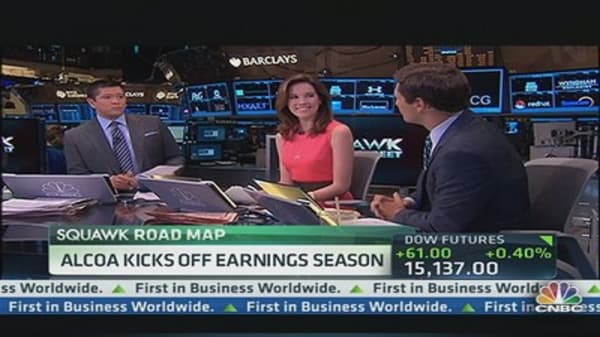Elsewhere:
1) sitting in Europe, it was quite the scene to watch U.S. stocks rally almost every single day I was gone, while bond yields continued to back up. But the stock market is not falling apart: as Dan Greenhaus and others have pointed out, the 10-year yield has gone from 1.61 percent to 2.70 percent in the last two months, but the S&P 500 is up 3.1 percent.
And with the bullish June jobs report on Friday, we may finally have enough growth to support the stock market.
2) On the other hand, I keep waiting for some kind of titanic outflows from bond funds. I see outflows, but nowhere near 'titanic." Vanguard Total Bond Market, the largest bond ETF, is down 4.9 percent year to date, most of it in the last two months. Is that enough to precipitate huge outflows?
There are outflows, but they aren't as great as the media seems to be hyping. The Vanguard fund, for example, had $483 million in outflows in the second quarter, and has seen $64 million in outflows in just the first week of the third quarter. That, however, is only about 3 percent of the total value of the fund. That is notable, but I would not call it a tidal wave - at least not yet.
We have seen some rotation down the duration curve...so some money is moving out of, say, long term bonds into short-term bond funds. An avalanche out of bonds, though? It doesn't appear that way.
The irony, of course, is that everyone who is yield hungry who has cash on the sidelines has to take a look at current bond prices.
That backup in yields has to be competition for other yield strategies, like dividend stocks. It seems to me that puts something of a floor under the panic trade of selling all bonds.
3) European stocks are up, but Asian stocks are all down on concerns about slowing in China.
4) Earnings: how bad? Perhaps not as bad as everyone is screaming: it's another low-bar quarter. We start second quarter earnings today with the usual negative slant from the Wall Street Journal, Reuters, and others: that EPS gains are again meager (S&P Capital IQ has 2.9 percent), in the low single digits at best, and that top line growth is essentially flat (Cap IQ has minus 0.2 percent). There are the usual dire warnings that this cannot continue (note: it has been continuing, for over a year, but hey why interrupt the narrative?).
And there's a new wrinkle: a high percentage of negative guidance. 111 companies have provided guidance, 78 percent were negative, according to Cap IQ. That is a high percentage.
Yet every quarter, about 65 percent of companies beat the numbers, and by an average of about 3 percent points. There is no reason to believe that this quarter will be any different.
What this means is this: if you accept 2.9 percent bottom line gains and an average beat of 3 percent points, the historical trend is that earnings will rise 5.9 percent of so in the second quarter.
That is more than enough to keep the stock market up. It may not be enough for double digit gains, but it is good enough for modest growth.
In case you are wondering, the 15 year average is 8 percent gains.
—By CNBC's Bob Pisani












